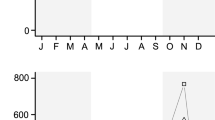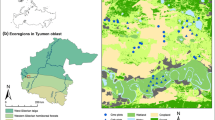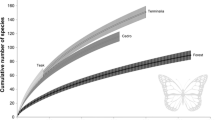Abstract
The Atlantic forest is one of the most diverse biomes on Earth but human activities are transforming this ecosystem into one of the most endangered. Most remnant old-growth rainforest is embedded within a mosaic of regenerating forest, tree plantations, pastures, and agricultural production. This has left a large percentage of the region’s endemic species threatened with extinction. Butterflies are considered as sensitive indicators of ecological conditions, especially in the Atlantic forest. This community can provide a window into animal response to restoration and how recovering habitats are used by native animal communities. The primary goal of this paper was to determine if butterfly communities respond to measures of structural recovery in naturally regenerating and re-forested pastures, and if this response increases the similarity of recovering butterfly communities relative to those of intact forests. Butterfly communities were sampled using two sampling methodologies, passive bait trapping and timed meander counts. These data sets were combined and correlated to assessment of habitat structure. We found that butterfly communities respond rapidly to structural changes in habitats as forest structure recovers on abandoned and restored pastures. While many species of mature forest inhabiting butterflies use regenerating forests as habitat, our young forests also retained an almost intact community of ruderal pasture inhabiting butterflies as well, indicating that these habitats retain many features of highly disturbed pastures. We suggest that measures of beta-diversity, which can be used to assess convergence in community structure, are far superior to the alpha-diversity measures that are typically used for assessing restoration recovery.





Similar content being viewed by others
References
Barlow J, Overal W, Araujo I, Gardner T, Peres C (2007a) The value of primary, secondary and plantation forests for fruit-feeding butterflies in the Brazilian Amazon. J Appl Ecol 44:1001–1012
Barlow J, Gardner T, Araujo I, Avila-Pires T, Bonaldo A, Costa J, Esposito M, Ferreira L, Hawes J, Hernandez M, Hoogmoed M, Leite R, Lo-Man-Hung N, Malcolm J, Martins M, Mestre L, Miranda-Santos R, Nunes-Gutjahr A, Overal W, Parry L, Peters S, Ribeiro-Junior M, da Silva M, Motta C, Peres C (2007b) Quantifying the biodiversity value of tropical primary, secondary, and plantation forests. Proc Natl Acad Sci 104:18555–18560
Bihn J, Gebauer G, Brandl R (2010) Loss of functional diversity of ant assemblages in secondary tropical forests. Ecology 91:782–792
Brown J, Brown K, Freitas A (2000) Atlantic forest butterflies: indicators for land-scape conservation. Biotropica 32:934–956
Carneiro E, Mielke O, Casagrande M, Fiedler K (2014) Community structure of skipper butterflies (Lepidoptera, Hesperiidae) along elevational gradients in Brazilian Atlantic Forest reflects vegetation type rather than altitude. PLoS ONE 9:e108207
Cheung K, Liebsch D, Marques M (2010) Forest recovery in newly abandoned pastures in Southern Brazil: implications for the Atlantic Rain Forest Resilience. Nat Conserv 8:66–70
Clarke K, Somerfield P, Gorley R (2008) Testing of null hypotheses in exploratory community analyses: similarity profiles and biota-environment linkage. J Exp Mar Biol Ecol 366:56–69
Cristescu R, Rhodes J, Frere C, Banks P (2013) Is restoring flora the same as restoring fauna? Lessons learned from koalas and mining rehabilitation. J Appl Ecol 50:421–431
Dean W (1996) A ferro e fogo—a história e a devastação da Mata Atlântica Brasileira. Companhia das Letras, São Paulo
Dolibaina D, Mielke O, Casagrande M (2011) Borboletas (Papilionoidea e Hesperioidea) de Guarapuava e arredores, Paraná, Brasil: um inventário com base em 63 anos de registros Butterflies (Papilionoidea and Hesperioidea) from Guarapuava and vicinity, Paraná, Brazil: an inventory based on records of 63 years. Biota Neotropica 11:341–354
Ferretti A, de Britez R (2006) Ecological restoration, carbon sequestration and biodiversity conservation: the experience of the Society for Wildlife Research and Environmental Education (SPVS) in the Atlantic Rain Forest of Southern Brazil. J Nat Conserv 14:249–259
Fiedler K, Truxa C (2012) Species richness measures fail in resolving diversity patterns of speciose forest moth assemblages. Biodivers Conserv 21:2499–2508
Filgueiras B, Melo D, Leal I, Tabarelli M, Freitas A, Iannuzzi L (2016) Fruit-feeding butterflies in edge-dominated habitats: community structure, species persistence and cascade effect. J Insect Conserv 20:539–548
Francini R, Duarte M, O Mielke, Caldas A, Freitas A (2011) Butterflies (Lepidoptera, Papilionoidea and Hesperioidea) of the “Baixada Santista” region, coastal São Paulo, southeastern Brazil. Rev Brasil Entomol 55:55–68
Freitas A, Iserhard C, dos Santos J, Carreira J, Ribeiro D, Melo D, Rosa A, Filho O, Accacio G, Uehara-Prado M (2014) Studies with butterfly bait traps: an overview. Rev Colomb Entomol 40:209–218
Grimbacher P, Catterall C (2007) How much do site age, habitat structure and spatial isolation influence the restoration of rain forest beetle species assemblages? Biol Conserv 135:107–118
Guariguata M, Ostertag R (2001) Neotropical secondary forest succession: changes in structural and functional characteristics. For Ecol Manag 148:185–206
Hansen M, Gibson D (2014) Use of multiple criteria in an ecological assessment of a prairie restoration chronosequence. Appl Veg Sci 17:63–73
Henderson P, Seaby R (2007) Community analysis package version 4.0, Pisces Conservation Ltd, Lymington
Hood G (2006) PopTools version 2.7.5. http://www.cse.csiro.au/poptools
Howard P, Viskanic P, Davenport T, Kigenyi F, Baltzer M, Dickenson C, Lwanga J, Matthews R, Balmford A (1998) Complementarity and the use of indicator groups for reserve selection in Uganda. Nature 392:472–475
Kati V, Devillers P, Dufrênec M, Legakisd A, Vokoue D, Lebrunf P (2004) Hotspots, complementarity or representativeness? designing optimal small-scale reserves for biodiversity conservation. Biol Conserv 120:471–480
Marques C, Zwiener V, Ramos F, Borgo M, Marques R (2014) Forest structure and species composition along a successional gradient of Lowland Atlantic Forest in Southern Brazil. Biota Neotropica 14:1–11
Mielke C (1994) Papilionoidea e Hesperioidea (Lepidoptera) de Curitiba e seus arredores, Paraná, Brasil, com notas taxonômicas sobre Hesperiidae. Rev Brasil Zool 11:759–776
Murray-Smith C, Brummitt N, Oliveira-Filho A, Bachman S, Moat J, Lughadha E, Lucas D (2008) Plant diversity hotspots in the Atlantic Coastal Forests of Brazil. Conserv Biol 23:151–163
Myers N, Mittermeier R, Mittermeier C, Fonseca G, Kent J (2000) Biodiversity hotspots for conservation priorities. Nature 403:853–858
Oertli S, Müller A, Steiner D, Breitenstein A, Dorn S (2005) Cross-taxon congruence of species diversity and community similarity among three insect taxa in a mosaic landscape. Biol Conserv 126:195–205
Pielou E (1975) Ecological diversity. Wiley, New York
Ribeiro MC, Metzger JP, Martensen AC, Ponzoni FJ, Hirota MM (2009) The Brazilian Atlantic Forest: how much is left, and how is the remaining forest distributed? Implications for conservation. Biol Conserv 142:1141–1153
Ribeiro DB, Prado PI, Brown KSJR, Freitas AVL (2010) Temporal diversity patterns and phenology in fruit-feeding butterflies in the Atlantic forest. Biotropica 42:710–716
Ruiz-Jaen M, Aide T (2005) Restoration success: how is it being measured? Restor Ecol 13:569–577
Sáfián S, Csontos G, Winkler D (2011) Butterfly community recovery in degraded rainforest habitats in the Upper Guinean forest zone (Kakum forest, Ghana). J Insect Conserv 15:351–359
Samways M (1997) Insect conservation biology. Chapman and Hall, New York
Sant’Anna C, Ribeiro D, Garcia L, Freitas A (2014) Fruit-feeding butterfly communities are influenced by restoration age in tropical forests. Restor Ecol 22:480–485
Seaby R, Henderson P (2007) Species diversity and richness 4, Pisces Conservation Ltd, Lymington
Shuey J (1997) An optimized portable bait trap for quantitative sampling of butterflies. Trop Lepid 8:1–4
Shuey J, Metzler E, Tungesvick K (2012) Moth communities correspond with plant communities in Midwestern (Indiana, USA) sand prairies and oak barrens and their degradation endpoints. Am Midl Nat 167:273–284
Siminski A, Fantini A, Guries R, Ruschel A, dos Reis M (2011) Secondary forest succession in the Mata Atlantica, Brazil: floristic and phytosociological trends. ISRN Ecology 2011 Article ID 759893, p 19
Sobanski N, Marques M (2014) Effects of soil characteristics and exotic grass cover on the forest restoration of the Atlantic Forest region. J Nat Conserv 22:217–222
Su J, Debinski C, Jakubauskas M, Kindscher K (2004) Beyond species richness: community similarity as a measure of cross-taxon congruence for coarse-filer conservation. Conserv Biol 18:167–173
Suding K (2011) Toward an era of restoration in ecology: successes, failures, and opportunities ahead. Ann Rev Ecol Evol Syst 42:465–487
Acknowledgements
Staff at the Sociedade de Pesquisa em Vida Selvagem e Educação Ambiental welcomed and facilitated our field work and were gracious hosts during our prolonged visits. This work was made possible by Leandro Baumgarten, Science Manager for The Nature Conservancy’s program in Brazil.
Author information
Authors and Affiliations
Corresponding author
Rights and permissions
About this article
Cite this article
Shuey, J., Labus, P., Carneiro, E. et al. Butterfly communities respond to structural changes in forest restorations and regeneration in lowland Atlantic Forest, Paraná, Brazil. J Insect Conserv 21, 545–557 (2017). https://doi.org/10.1007/s10841-017-9994-y
Received:
Accepted:
Published:
Issue Date:
DOI: https://doi.org/10.1007/s10841-017-9994-y




